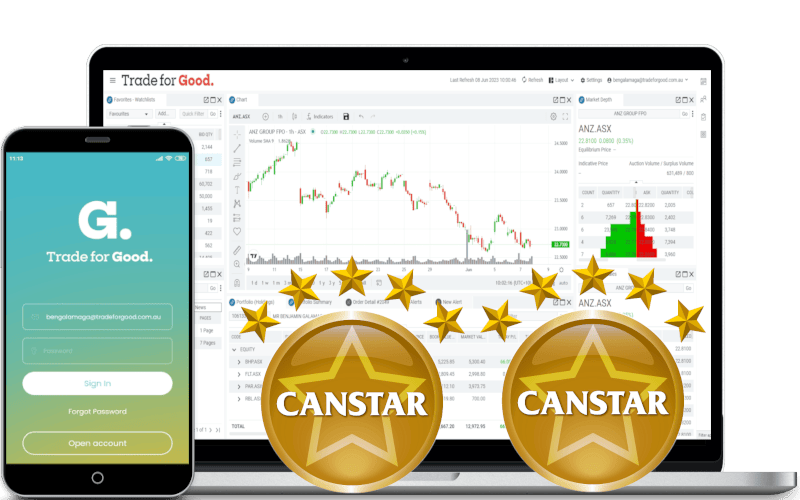
What is Market Capitalisation?
Market capitalisation, or “market cap”, is the aggregate market value of a company represented in a dollar amount.
The formula for the market cap is:

Market cap is also used to compare and categorize the size of companies among investors and analysts. This metric is instrumental in classifying companies into different categories, such as large-cap, mid-cap, and small-cap.
Types of Market Capitalisations
Capitalization, or market capitalization, represents the total dollar value of a company’s outstanding shares and can vary widely among different companies. This metric is used to categorize companies into various market cap ranges:
 Large-cap: Companies with a market capitalization of $10 billion or more. These are typically well-established industry leaders with stable revenues and profits.
Large-cap: Companies with a market capitalization of $10 billion or more. These are typically well-established industry leaders with stable revenues and profits.
 Mid-cap: Companies with a market capitalization between $2 billion and $10 billion. These companies often offer a balance of growth potential and stability, appealing to investors looking for moderate risk and reward.
Mid-cap: Companies with a market capitalization between $2 billion and $10 billion. These companies often offer a balance of growth potential and stability, appealing to investors looking for moderate risk and reward.
 Small-cap: Companies with a market capitalization between $300 million and $2 billion. These are generally younger companies with higher growth potential but also higher risk and volatility.
Small-cap: Companies with a market capitalization between $300 million and $2 billion. These are generally younger companies with higher growth potential but also higher risk and volatility.
 Micro-cap: Companies with a market capitalization between $50 million and $300 million. These companies are often in the early stages of development and carry significant risk but can offer substantial returns.
Micro-cap: Companies with a market capitalization between $50 million and $300 million. These companies are often in the early stages of development and carry significant risk but can offer substantial returns.
 Nano-cap: Companies with a market capitalization of under $50 million. These are typically very small, highly speculative companies with high risk and potential for high reward.
Nano-cap: Companies with a market capitalization of under $50 million. These are typically very small, highly speculative companies with high risk and potential for high reward.
Mid and Large Cap Key Takeaways
- Return on Investment:
Investing in mid and large-cap stocks does not necessarily guarantee larger returns. While these companies are generally more stable and established, their growth rates may be slower compared to smaller companies. Therefore, investors should not expect explosive gains but can anticipate more steady and predictable returns over time. - Dividends:
In Australia, many mid and large-cap stocks offer dividends to shareholders. These regular payments can provide a steady income stream, making these stocks attractive to income-focused investors. Dividends can also help offset potential lower capital appreciation compared to smaller, growth-oriented companies.

- Price Stability and Volatility:
Mid and large-cap stocks typically have higher average share prices and exhibit less price volatility. This stability is due to their established market presence, diversified revenue streams, and greater financial resources. As a result, these stocks are generally considered safer investments, especially during market downturns. - Analyst Coverage and Institutional Trading:
Mid and large-cap stocks are the most closely followed by financial analysts and are heavily traded by institutional investors. This high level of scrutiny and institutional participation can result in more efficient pricing, reducing opportunities for individual investors to find undervalued stocks. Additionally, the significant presence of institutional traders can make it more challenging for individual investors to execute large trades without affecting the stock price.

- Market Influence:
Due to their size and market capitalization, mid and large-cap companies often have a significant influence on market indices and overall market performance. Their stability and predictability can contribute to the overall resilience of investment portfolios, providing a counterbalance to the higher volatility of smaller-cap stocks. - Diversification and Risk Management:
Including mid and large-cap stocks in an investment portfolio can enhance diversification and reduce overall risk. These stocks tend to have more predictable earnings, established business models, and a track record of performance, which can help mitigate the risks associated with more volatile investments.
Small Cap Key Takeaways
- Investment Strategy and Growth Opportunities:
Small-cap stock investors typically aim to outperform institutional investors by identifying and capitalizing on high-growth opportunities. These companies are often in the early stages of development or operate in niche markets with significant potential for expansion. - Historical Performance:
Historically, small-cap stocks have delivered higher returns compared to large-cap stocks over the long term. This outperformance is often attributed to their agility, innovation, and ability to quickly adapt to market changes. - Risk and Volatility:
Small-cap stocks are inherently more volatile and riskier than their large-cap counterparts. This increased risk is due to factors such as limited financial resources, less diversified business models, and greater sensitivity to economic downturns.

- Growth Potential:
The smaller size of small-cap companies means they have more room for growth. Investors may find opportunities for substantial gains as these companies expand their market presence, develop new products, or enter new markets. However, this potential for growth comes with the trade-off of higher risk. - Market Dynamics:
Small-cap stocks are often less followed by analysts and institutional investors, creating opportunities for individual investors to uncover undervalued or overlooked companies. This less crowded space can offer unique investment prospects for those willing to conduct thorough research. - Diversification and Long-Term Strategy:
Including small-cap stocks in a diversified investment portfolio can enhance overall returns, but it also requires a tolerance for short-term volatility. Investors should consider a long-term perspective to ride out market fluctuations and capitalize on the growth potential of small-cap companies.
Nano and Micro Caps Key Takeaways
Nano and micro-cap stocks are characterized by their small market capitalizations, which typically indicate companies with smaller total asset values compared to larger-cap stocks. This small size makes them inherently more volatile and riskier investments than larger-cap stocks.
One significant risk factor for nano and micro-caps is their lower liquidity and smaller shareholder base. This lack of trading volume and fewer investors can lead to significant price fluctuations, often resulting in large price swings in response to relatively small changes in buying or selling pressure.

Despite these risks, nano and micro-cap stocks have the potential to deliver substantial returns, especially during bullish market periods. Their smaller size allows them to capitalize on niche opportunities and rapid growth potential that larger companies might overlook or be unable to pursue due to their size.
Investors interested in nano and micro-cap stocks should carefully weigh the higher volatility and liquidity risks against the potential for outsized returns, particularly in favorable market conditions. Due diligence and thorough research are crucial when considering investments in this segment of the market.

Where can you see the market capitalization?
In the Fundamentals, click on the 3 dashes in the top left corner, Fundamentals, then Statistics.

Under Valuation Measures, it will display the Market Cap.

The Bottom Line
Market capitalisation affects share performance because it reflects a company’s size, stability, and growth potential. Larger-cap stocks tend to be more stable and less volatile, while smaller-cap stocks often offer higher growth potential but come with greater risk and volatility. This influences investor expectations and market behavior.

You can download the offline guide here Market Capitalisation

What you learn here has been used in our Trade for Good software.
Click on the button to find our software education videos.
You can read more of our educational articles in the Trade for Good Learn section
Trade for Good Learn

